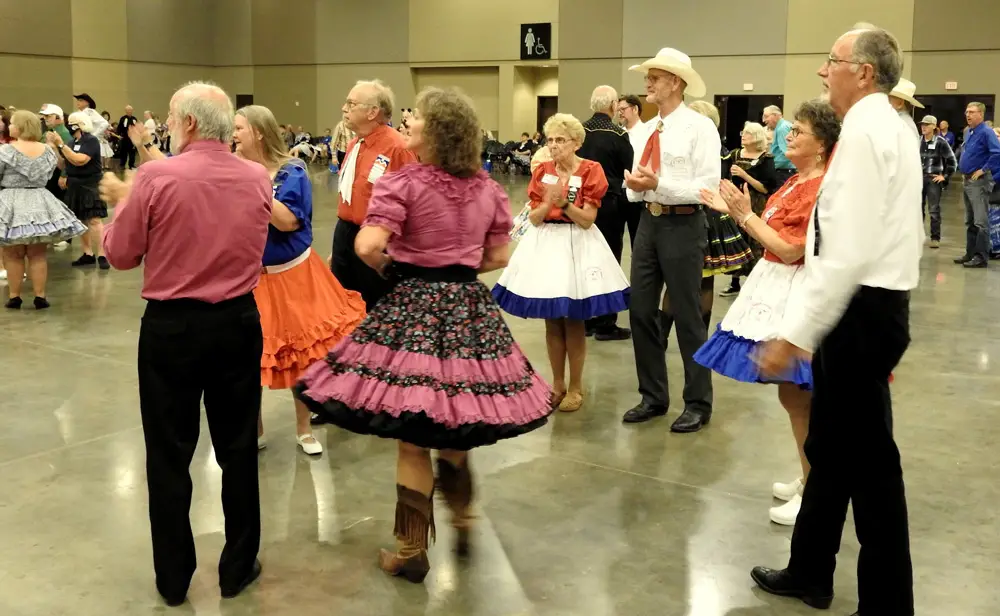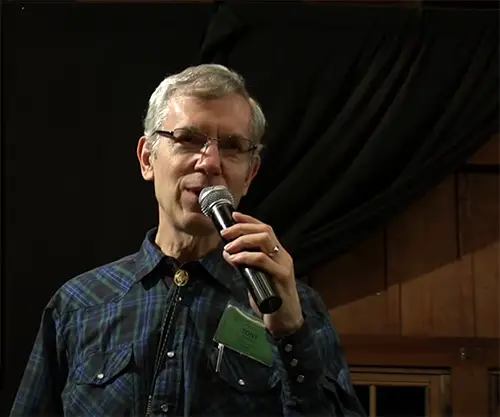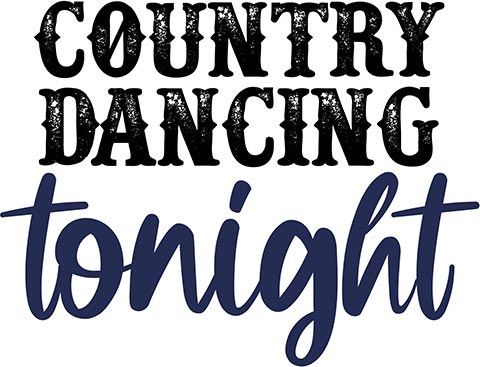
As I’ve been country dancing, now for a few years, sometimes people mistake what I’m involved in for Square Dancing. It’s not. But this has brought up the question, specifically, what is Square Dancing? Since I love to dance and I have some good childhood memories of learning to do square dancing in grade school (dating myself I know) I thought it would be fun to research it some more and let all of you know about it. Maybe you’d like to try it out.
Square dancing is an American folk dance that is not easy to learn as it requires quick response to caller cues, memory, and physical coordination. It is called square dancing because of the formation of the dancers; four couples and eight dancers stand in a square formation.
Square Dancing has been around since the early days of this country and came over here via the English and French immigrants. Its roots originate in the English Country Dance, Morris Dance, and the French Quadrille (think of those Jane Austen movies where they are dancing in long, intertwining lines.)
Like line dancing, there is a lot to learn. It requires quick response to caller cues, memory, and physical coordination.
Starting square dancing can be overwhelming because there is much to learn and understand. This article will explain what square dancing is and the basics you need to get started. Hopefully, with some effort and a little patience and practice, you can soon be on the path to square dancing.
What Is Square Dancing?
Square dancing has been able to withstand the test of time. The history of square dance has its roots in England and France.
Square dancing is a form of folk dance that came to America with the English and French immigrants. Square dancing has its roots in the English Country Dance, Morris Dance, and the French Quadrille. However, it has evolved into something that has truly become an American folk dance.
Please read below to learn more about what makes up this popular dance.
The Square
Since there are four couples in the square, it can quickly get complicated during cueing. Thus, there are naming conventions so dancers can follow the cues and lessen the complexity of coordinating several dancers.
The couples are numbered one through four. The couple closest to the caller is couple 1. The couple counterclockwise to couple 1 is couple 2, and so on. The couple facing you is your opposite.
The couples are further designated for clarity into further numbers. For example, Couples 1 and 3 are the heads of the square or the head couple. Couples 2 and 4 are referred to as the sides of the square or the side couples. In all, the four couples are called a squared set or a static set.
The Caller
Square dancing is generally done with a caller. A caller is a person who cues or announces the dance steps. The dancers follow the caller’s cues. Hence, the caller plays a significant role in square dancing.
Some callers follow traditional square dancing, where there is a predetermined order of steps, and the ordering of the steps is repeated. However, square dancing has evolved, however, and modern square dancing allows the caller to implement various steps, albeit still following the rhythm of the music.

Square dancing is generally done with a caller. A caller is a person who cues or announces the dance steps. The dancers follow the caller’s cues. Hence, the caller plays a significant role in square dancing.
Some callers follow traditional square dancing, where there is a predetermined order of steps, and the ordering of the steps is repeated. Square dancing has evolved, however, and modern square dancing allows the caller to implement various steps, albeit following the rhythm of the music.
Know Your Partner and Your Corner
Some forms of dance are partner optional, but not square dancing. Your partner stands beside you in the square formation with the other three couples. For reference, the man stands on the left in each pairing.
Besides your partner, there is another important person; this person is your corner. The corner is the lady on the man’s left and the man on the lady’s right.
Basic Square Dancing Steps
Square dancing is a sequence of steps followed by dancers with cueing from a caller. While there are many steps, there are several that are the most common- and easy to learn. Overall, there are six basic calls for square dancing. They will each be explained briefly below.
- Circle Left. This cue is self-explanatory; the dancers link hands while walking in a circle to the left.
- Allemande Left. This move consists of turning to face your corner. The pair link at the forearms. They walk in a circle until they face their partner again.
- Do Si Do. When a do si do is called, the couple will walk towards, then around their partner, and return to their original places.
- Right and Left Grand. Right, and left grand can be overwhelming the first few times. Couples weave in and out of the circle; men go in one direction while women go in the other.
- Promenade. The promenade is done as a couple. All turn to the right and walk counterclockwise around the circle.
- Ladies Chain. This step can also be overwhelming at first—the ladies chain across the circle, extending hands and pulling each other across.
- Swing. “Swing your partner” may be a term you have heard before. The couples interlock at the elbows and turn around in a circle.
- Star. This cue can be done with the right hands or left. All join hands at the wrist in the center and walk clockwise.
Is Square Dancing Hard to Learn?
Any form of dance can be challenging to pick up on. Square dancing is no different. With the requirement of seven other people, there are many moving parts- literally. Square dancing is not a form of dance that you can easily practice or do alone.
Square dancing can be hard to learn because it requires you to memorize challenging cues and coordinate smooth and rhythmic movements of the caller’s call with other people. This can be physically and mentally demanding along with the requirement that the dancers work together as a group in music timed coordination.
But hey! That’s what makes it fun too. For those of you who have learned a few line dances, I don’t think this would be too challenging.
Along with the above issues of memorizing cues and coordinating with other dancers, a few more elements may challenge new dancers:
- As the caller decides on a series of cues, you’ll need to think on your feet and coordinate your movements quickly.
- Square dancing will require you to move rhythmically and smoothly and respond well to timing. (Piece of cake for line dancers).
Although square dancing may be a completely easy form of dance to learn, it seems like it is worth the time and effort. It is a fun and highly social dance, and it is also great exercise.
It has the benefits of being low impact and aerobic. Square dancing contributes to improving the cardiovascular system and strengthening bones.
Square Dancing Terms to Know
If you are new to square dancing, it can be overwhelming with all the different terms. Some of these terms will be called out during the dancing. Others are just used and common terminology in square dancing halls.
Below are some terms that you should familiarize yourself with to get started:
- Square Set. A square set is another term for the four couples in each square.
- Handhold. The handhold is simply joining hands with another dancer. This hold can be your partner or another member of the square.
- Home position. The home position is the original position of each dancer.
- Center. This cue is straightforward. It is the center of each square.
- Right-hand lady. This term refers to the lady of the couple to the right.
- Honor your partner/honor your corner. Man bows to the lady, and the lady curtsies to the man. It is done with the partner and the corner.
Square Dancing Attire
Different styles of dance utilize different attire, from clothing down to shoes. While square dancing does not require specific shoes and clothing to do so appropriately and safely, you can still expect a dress code.
You are more likely than not to find a dress code at square dance venues. As with other dance styles, the attire does differ between women and men.
Women
Women often wear full skirts with petticoats underneath them that make the skirts appear full. Some women opt to wear crinolines, but this is not necessary. The women should wear a pair of low-heeled shoes that are comfortable because the steps can be physically demanding and challenging to execute in high heels.
Men
Men typically dress in western attire. This clothing includes long-sleeved flannel shirts in a variety of colors. Leather shoes are often worn, and a favorite is cowboy boots. Some men choose to wear a cowboy hat to complete the “all American” look.
Square Dancing Versus Line Dancing
Each dance is what its name says: You are either in a square or line. In spite of the obvious, they are sometimes assumed to be the same thing.
The primary difference between line dancing and square dancing is simple. Line dancing involves memorizing choreography. Square dancing is a response to caller cues and coordinated moves with your partner and your “square”. And it is also more structured, requiring groups of eight with specified partners.
It may be attractive to you if you prefer something a little more low impact but still aerobic.
For an in-depth comparison check out my article on just this question: How are Line Dancing & Square Dancing Different?
Conclusion
Square dancing may not be completely easy to learn or even your thing, but it is a fun social dance form that people have been doing for hundreds of years. Maybe with this overview, you will have a beginning point of reference and find your interest sparked enough to find a group and get involved.
Note: Since my blog is about Country Dancing, I thought I’d give a place on it to Square Dancing. It seems to qualify and fall under that umbrella. While I’m not a square dancer myself, in doing some research for the articles on the site, it seems like there is a lot of square dancing going on! I did wonder if square dancing is a dying art. Check out this article that addresses this a little. The key to its survival will be how to bring young people to the dance. With it no longer part of the public school curriculum, that might be challenging. Check out some of the sources below to keep exploring more about Square Dancing.
Sources
- Square Up Fashions: History of Square Dance What is Square Dancing and How Did It Start?
- Country Dancing Tonight: How are Line Dancing & Square Dancing Different?
- Masterclass; All About Square Dance: A Brief History of Square: A Brief History of Square Dance
- Hallmark: How to Square Dance- 12 Basic Calls for Square Dancing
